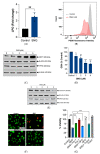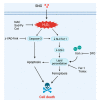Sanguinarine Induces H2O2-Dependent Apoptosis and Ferroptosis in Human Cervical Cancer
- PMID: 35892694
- PMCID: PMC9331761
- DOI: 10.3390/biomedicines10081795
Sanguinarine Induces H2O2-Dependent Apoptosis and Ferroptosis in Human Cervical Cancer
Abstract
Sanguinarine (SNG) is a benzophenanthridine alkaloid isolated mainly from Sanguinaria canadensis, Chelidonium majus, and Macleaya cordata. SNG is considered an antineoplastic agent based on its cytotoxic activity against various tumors. However, the exact molecular mechanism through which SNG mediates this activity has not been elucidated. Here, we report that SNG induces death in human cervical cancer (HeLa) cells through activation of two interdependent cell death pathways-apoptosis and ferroptosis. SNG-induced apoptosis was characterized by caspase activation and PARP cleavage, while ferroptosis involved solute carrier family 7 member 11 (SLC7A11) down-regulation, glutathione (GSH) depletion, iron accumulation, and lipid peroxidation (LPO). Interestingly, incubation with caspase inhibitor z-VAD-fmk not only inhibited the features of apoptosis, but also negated markers of SNG-induced ferroptosis. Similarly, pretreatment with ferroptosis inhibitor ferrostatin-1 (Fer-1), apart from rescuing cells from SNG-induced ferroptosis, also curbed the features of SNG-induced apoptosis. Our study implies that, together, apoptosis and ferroptosis act as partners in the context of SNG mediated tumor suppression in HeLa cells. Importantly, SNG increased the generation of reactive oxygen species (ROS), and ROS inhibition blocks the induction of both apoptosis and ferroptosis. These findings highlight the value of continued investigation into the potential use of SNG as an antineoplastic agent.
Keywords: LPO; ROS; apoptosis; ferroptosis; labile iron; sanguinarine.
Conflict of interest statement
The authors have no conflict of interest to declare.
Figures







References
-
- Rahman A., Pallichankandy S., Thayyullathil F., Galadari S. Critical role of H2O2 in mediating sanguinarine-induced apoptosis in prostate cancer cells via facilitating ceramide generation, ERK1/2 phosphorylation, and Par-4 cleavage. Free Radic. Biol. Med. 2019;134:527–544. doi: 10.1016/j.freeradbiomed.2019.01.039. - DOI - PubMed
-
- Gu S., Yang X.C., Xiang X.Y., Wu Y., Zhang Y., Yan X.Y., Xue Y.N., Sun L.K., Shao G.G. Sanguinarine-induced apoptosis in lung adenocarcinoma cells is dependent on reactive oxygen species production and endoplasmic reticulum stress. Oncol. Rep. 2015;34:913–919. doi: 10.3892/or.2015.4054. - DOI - PubMed
Grants and funding
LinkOut - more resources
Full Text Sources

